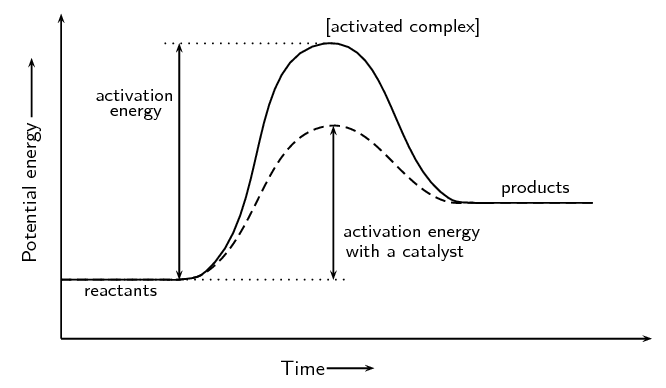
How can I represent an endothermic reaction in a potential energy diagram?
Answer
471.6k+ views
Hint: The potential energy diagram represents the change in the potential energy of the system when the reactant compound undergoes chemical reaction to form a product. In an endothermic reaction, the heat is absorbed by the system. The potential energy graph is drawn between potential energy and time.
Complete step by step answer:
The endothermic reaction is defined as the reaction where heat is absorbed. The energy changes that take place during the chemical reaction is shown by a diagram which is known as a potential energy diagram.
The potential energy diagram shows the change in the potential energy of the system when the reactant compound changes to produce.
For the endothermic reaction the enthalpy change
The potential energy diagram for endothermic reaction is shown below.

In the potential energy diagram of endothermic reaction, the potential energy of the reactant should be lower than the product. The hump is higher than the beginning which shows the system gains energy during the chemical reaction which is the activation energy complex. The reacting particles must have enough energy to overcome the barrier.
Note:
In endothermic reaction, the enthalpy change should be greater than zero
Complete step by step answer:
The endothermic reaction is defined as the reaction where heat is absorbed. The energy changes that take place during the chemical reaction is shown by a diagram which is known as a potential energy diagram.
The potential energy diagram shows the change in the potential energy of the system when the reactant compound changes to produce.
For the endothermic reaction the enthalpy change
The potential energy diagram for endothermic reaction is shown below.

In the potential energy diagram of endothermic reaction, the potential energy of the reactant should be lower than the product. The hump is higher than the beginning which shows the system gains energy during the chemical reaction which is the activation energy complex. The reacting particles must have enough energy to overcome the barrier.
Note:
In endothermic reaction, the enthalpy change should be greater than zero
Latest Vedantu courses for you
Grade 11 Science PCM | CBSE | SCHOOL | English
CBSE (2025-26)
School Full course for CBSE students
₹41,848 per year
Recently Updated Pages
Master Class 11 Business Studies: Engaging Questions & Answers for Success

Master Class 11 Accountancy: Engaging Questions & Answers for Success

Master Class 11 Computer Science: Engaging Questions & Answers for Success

Master Class 11 English: Engaging Questions & Answers for Success

Master Class 11 Social Science: Engaging Questions & Answers for Success

Master Class 11 Economics: Engaging Questions & Answers for Success

Trending doubts
Which one is a true fish A Jellyfish B Starfish C Dogfish class 11 biology CBSE

State and prove Bernoullis theorem class 11 physics CBSE

1 ton equals to A 100 kg B 1000 kg C 10 kg D 10000 class 11 physics CBSE

In which part of the body the blood is purified oxygenation class 11 biology CBSE

One Metric ton is equal to kg A 10000 B 1000 C 100 class 11 physics CBSE

Difference Between Prokaryotic Cells and Eukaryotic Cells




